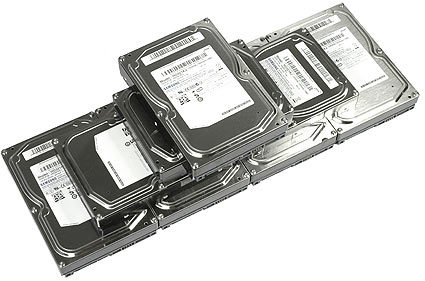RAID Scaling Charts, Part 1
RAID Testing With 2-8 Drives
Most enthusiast and mainstream users would consider setting up a RAID array mainly for performance reasons - few really care about data safety. For this reason, the majority of arrays installed consists of only two drives, which run a simple RAID 0 stripe set. Haven’t you ever asked yourself how these RAID arrays scale as you increase the number of hard drives? Is it worth it? When does the array hit bottlenecks? Administrators and über users be ready: here come the ultimate Tom’s Hardware RAID Scaling Charts.
Our intention is as simple as it is ambitious: to benchmark all common RAID modes with as few drives as possible, but also going up to as many as eight hard drives. We consider this the maximum drive count for enthusiast PCs and entry-level servers, because fitting more hard drives into a single computer case might be difficult unless you move to external eSATA appliances. Moving on to professional RAID controllers with more than eight ports will also require multi-lane cables and expensive appliances, sometimes referred to as "mini SAS", instead of individual cables per drive.
This is the first of two articles. We will discuss RAID 0, RAID 1 and RAID 0+1 here, while part 2 will deal with RAID 5 and RAID 6.
Why RAID Charts?
There are many reasons why we decided to carry out this project. On the one hand, there are numerous applications that require high storage performance: think of audio or video applications that rely on a constant data stream, such as high resolution HD video recording or audio recording. As soon as you reduce or drop compression your data rates will skyrocket; they also will with multiple recording channels. File servers in large networks also need to be able to provide software updates in a fast manner to multiple client PCs at the same time. Or think of data collection servers that store dozens of surveillance camera photos per second, communication logs, or data coming from sensors within a particle accelerator or other scientific application.
Even so, high throughput isn’t everything: some applications require hundreds of I/O operations per second. Large databases that cannot be cached into system memory rely on high storage I/O performance as well. Here, you might think of wire transfers, credit card transactions, orders that affect inventory control systems, and so forth.
Our RAID charts include all the results that are important to find a good match between your application requirements and the number of hard drives you’ll need. We’ve included access time measurements, interface bandwidth performance, maximum, and average and minimum read and write transfer rates. We also include I/O performance benchmarks for typical applications such as file servers, web servers, database servers or workstations.
Join our discussion on this topic
Get Tom's Hardware's best news and in-depth reviews, straight to your inbox.

Patrick Schmid was the editor-in-chief for Tom's Hardware from 2005 to 2006. He wrote numerous articles on a wide range of hardware topics, including storage, CPUs, and system builds.
